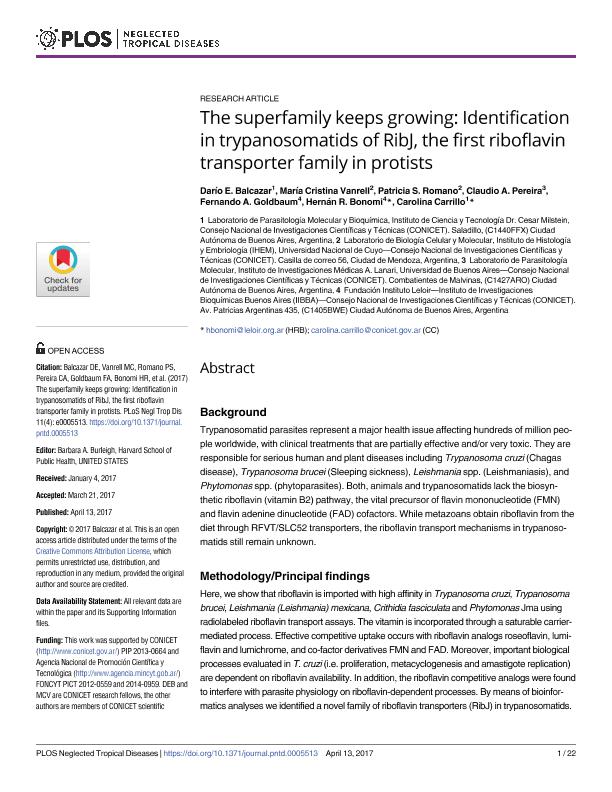Artículo
The superfamily keeps growing: Identification in trypanosomatids of RibJ, the first riboflavin transporter family in protists
Balcazar, Dario Emmanuel ; Vanrell, Maria Cristina
; Vanrell, Maria Cristina ; Romano, Patricia Silvia
; Romano, Patricia Silvia ; Pereira, Claudio Alejandro
; Pereira, Claudio Alejandro ; Goldbaum, Fernando Alberto
; Goldbaum, Fernando Alberto ; Bonomi, Hernán Ruy
; Bonomi, Hernán Ruy ; Carrillo, Carolina
; Carrillo, Carolina
 ; Vanrell, Maria Cristina
; Vanrell, Maria Cristina ; Romano, Patricia Silvia
; Romano, Patricia Silvia ; Pereira, Claudio Alejandro
; Pereira, Claudio Alejandro ; Goldbaum, Fernando Alberto
; Goldbaum, Fernando Alberto ; Bonomi, Hernán Ruy
; Bonomi, Hernán Ruy ; Carrillo, Carolina
; Carrillo, Carolina
Fecha de publicación:
04/2017
Editorial:
Public Library of Science
Revista:
Neglected Tropical Diseases
ISSN:
1935-2735
Idioma:
Inglés
Tipo de recurso:
Artículo publicado
Clasificación temática:
Resumen
Background: Trypanosomatid parasites represent a major health issue affecting hundreds of million people worldwide, with clinical treatments that are partially effective and/or very toxic. They are responsible for serious human and plant diseases including Trypanosoma cruzi (Chagas disease), Trypanosoma brucei (Sleeping sickness), Leishmania spp. (Leishmaniasis), and Phytomonas spp. (phytoparasites). Both, animals and trypanosomatids lack the biosynthetic riboflavin (vitamin B2) pathway, the vital precursor of flavin mononucleotide (FMN) and flavin adenine dinucleotide (FAD) cofactors. While metazoans obtain riboflavin from the diet through RFVT/SLC52 transporters, the riboflavin transport mechanisms in trypanosomatids still remain unknown. Methodology/Principal findings: Here, we show that riboflavin is imported with high affinity in Trypanosoma cruzi, Trypanosoma brucei, Leishmania (Leishmania) mexicana, Crithidia fasciculata and Phytomonas Jma using radiolabeled riboflavin transport assays. The vitamin is incorporated through a saturable carrier-mediated process. Effective competitive uptake occurs with riboflavin analogs roseoflavin, lumiflavin and lumichrome, and co-factor derivatives FMN and FAD. Moreover, important biological processes evaluated in T. cruzi (i.e. proliferation, metacyclogenesis and amastigote replication) are dependent on riboflavin availability. In addition, the riboflavin competitive analogs were found to interfere with parasite physiology on riboflavin-dependent processes. By means of bioinformatics analyses we identified a novel family of riboflavin transporters (RibJ) in trypanosomatids. Two RibJ members, TcRibJ and TbRibJ from T. cruzi and T. brucei respectively, were functionally characterized using homologous and/or heterologous expression systems. Conclusions/Significance: The RibJ family represents the first riboflavin transporters found in protists and the third eukaryotic family known to date. The essentiality of riboflavin for trypanosomatids, and the structural/biochemical differences that RFVT/SLC52 and RibJ present, make the riboflavin transporter -and its downstream metabolism- a potential trypanocidal drug target.
Archivos asociados
Licencia
Identificadores
Colecciones
Articulos(CIC)
Articulos de CENTRO DE INVEST.CARDIOVASCULARES (I)
Articulos de CENTRO DE INVEST.CARDIOVASCULARES (I)
Articulos(IHEM)
Articulos de INST. HISTOLOGIA Y EMBRIOLOGIA DE MEND DR.M.BURGOS
Articulos de INST. HISTOLOGIA Y EMBRIOLOGIA DE MEND DR.M.BURGOS
Articulos(IIBBA)
Articulos de INST.DE INVEST.BIOQUIMICAS DE BS.AS(I)
Articulos de INST.DE INVEST.BIOQUIMICAS DE BS.AS(I)
Citación
Balcazar, Dario Emmanuel; Vanrell, Maria Cristina; Romano, Patricia Silvia; Pereira, Claudio Alejandro; Goldbaum, Fernando Alberto; et al.; The superfamily keeps growing: Identification in trypanosomatids of RibJ, the first riboflavin transporter family in protists; Public Library of Science; Neglected Tropical Diseases; 11; 4; 4-2017; 1-22; e0005513
Compartir
Altmétricas



